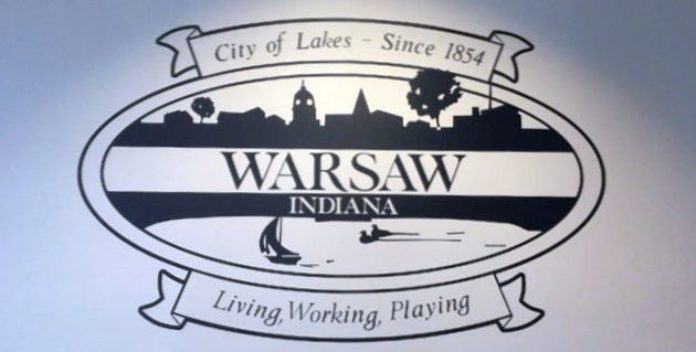Warsaw City Council approved the second sewage rate hike in two years Monday night.
Despite unanimous agreement that the city of Warsaw needs to expand its sewage treatment capacity, exactly how to spread the cost among customers was the central question as council debated whether to increase monthly bills in order to help pay for part of the $41 million public works project.
After two hours of debate, council voted 5-2 to hike sewage bills, marking the second bump in two years.
City officials had earlier predicted the total hike over two years could be as high as 39 percent, but that ended up being about 26 percent for homeowners.
Residential customers who average about 4,000 gallons of water per month will see about an $8 hike in their monthly bills over last year, while apartment residents will see roughly a 9 percent increase.
Combined with last year’s hike, the change for homeowners will be about 26 percent.
Small businesses could see between a 41- to 51-percent increase from two years ago.
Two towns, Leesburg and Winona Lake, which depend on Warsaw to treat sewage, will see their bills rise 12 percent compared to two years ago.
Mayor Joe Thallemer described the proposal as a mandatory expansion needed as the treatment plant begins to reach capacity, but also pointed out that the new rate is still below the state average of $41.24 per month.
At the same time, two city council members who opposed the hike – Ron Shoemaker and Cindy Dobbins – and others expressed concern about the possible 51 percent rate hike small businesses could face.
Council faced a looming deadline to pass the ordinance, which would allow the city to finalize financing with the state before a Dec. 15 deadline. Without approval, an estimated $5 million in savings would be in jeopardy.
Monday’s was the second and final needed by the city and the move caps two years of preparation by the city ahead of the biggest two-phase public works project in the city’s history.
The city this year began a $10 million repair of its sewer collection system across much of the city, and especially in the downtown area where some underground pipes are more than a century old.
The new rate hike is part of a $31 million plan to expand the treatment plant capacity from 4 million gallons per day to 6 million. It also will switch to a more energy-efficient anaerobic treatment process. Plans also lay the groundwork that would allow the city to double its capacity if ever needed.
The city outlined its case, saying that switching from a flat fee to one based on usage for residential customers is more equitable. Officials also contend the first cost-of-service study sought by the city since 2005 spreads the cost more fairly.
In many cases, some will pay less while others pay more, depending on usage.
Thallemer has called the changes a “truing up” of what customers should pay.
Council President Diane Quance supported the plan.
“I believe right now we’ve created the most equitable way of billing that we can with the data that we have,” Quance said. “I also believe this complex matter deserves ongoing monitoring – not every 10 years – and we need to review it.”
As the vote approached, councilman Mike Klondaris pointed out that a delay could cost the city $5 million.
Shoemaker said he was perplexed with the impact on the businesses. He said he doesn’t dispute the need, but did not like parts of the rate structure.
“I’ve had people in my district say they might go out of business and I’ve heard that people will move also,” Shoemaker said.
He said he wanted to slow down the process to provide more time to talk with landlords and business owners.
Thallemer asked Shoemaker what the alternative answer might be. “I don’t know how you’re going to change the methodology of the cost-of-service study and keep it valid,” he said. “How do you arrive at a rate that’s going to make everyone in this room happy?”
Dobbins said, “I’m voting no just because I want to keep our feet to the fire … to have further discussions.”
Several people asked why the meter size is such a big factor in some bills being more costly.
Utility Manager Brian Davison said the base fee connected to meter size helps cover the maintenance costs. Bigger meters provide the potential for bigger consumption, which the city has to be prepared for, he said.
That fee is combined with the charge based on usage to determine much of the monthly bill for residential customers.
Jeffrey Row, a partner with Umbaugh & Associates, and other officials suggested customers with large meters check with Indiana American Water utility to see if they could change to a smaller meter.
Duane Huffer, one of several residents who spoke about the proposal, questioned why anyone would oppose the plan.
“I don’t understand that,” Huffer said. “It appears to me we have a problem in our community that needs to be resolved and it appears to me what has been proposed takes care of that problem at a reasonable expense to all.”
But a representative of one laundry service worried about the impact.
Ashley Finney, with Quick Clean Laundry on Winona Lake, said she understood the need for a hike, but warned that they face a huge increase that they might have to pass on to customers.
She said their monthly bill is about $1,147, and that “I’m afraid to consider what it will look like after the second increase.”
The most contentious part of the meeting came with questions from former city councilman Kyle Babcock and apartment owner Chad Zartman.
Zartman urged the city to slow down and suggested more time was needed because of delays in releasing the cost-of-service study.
Zartman accused Thallemer of touting great results in the study in a newspaper column, but failing to quickly release the draft report, saying it was like a “bait and switch,” and that the final report came out at “the last minute.”
Thallemer took exception to that suggestion, pointing out the report had been released more than three weeks ago.
Thallemer reiterated his stance that the report not be released earlier because financing had not been finalized. Part of that included bids for the project that varied by $5 million.
“Can you imagine if I would have put the study out with a low amount of $26 million and it came in at $32 million? How much fun would you have had with that, Chad?” Thallemer asked.
Zartman and Thallemer also argued over the intent of the letter from Indiana Public Access Counselor Luke Britt.
Britt had sent a letter to Thallemer and Babcock, who had filed a complaint after the city declined to immediately release the draft report.
In the letter, Britt said he supports the release of such document as soon as possible, but also noted that Thallemer operated within the law by holding off on the release.
Zartman contended Britt ruled against Thallemer, who disputed that claim, adding, “I followed Indiana code to a ‘T.’”
Babcock, who said he supported the plan, nevertheless urged council to slow down and hold more meetings so businesses can respond to the proposal.
He suggested an error had been found in the rate study and wondered if there might be more errors.
Rowe said the error involved a sample bill from a specific apartment complex that was improperly calculated. He took responsibility for the mistake.
“That sample bill does not change the study. It does not change the numbers. It does not change the rate impact. I just want to make that clear,” Rowe said.





